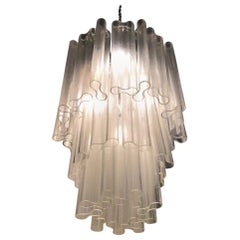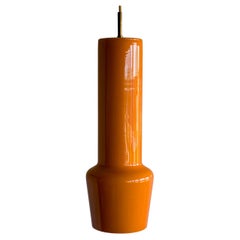Venini Chandeliers and Pendants
Beginning in the 1930s — and throughout the postwar years especially — Venini & Co. played a leading role in the revival of Italy’s high-end glass industry, pairing innovative modernist designers with the skilled artisans who created extraordinary chandeliers, sconces and other lighting in the centuries-old glass workshops on the Venetian island of Murano.
While the company’s co-founder, Paolo Venini (1895–1959), was himself a highly talented glassware designer, his true genius was to invite forward-thinking Italian and international designers to Murano’s hallowed workshops to create Venini pieces — among them Gio Ponti, Massimo Vignelli, Finnish designer Tapio Wirkkala, Thomas Stearns of the United States and Fulvio Bianconi.
Paolo Venini trained and practiced as a lawyer for a time, though his family had been involved with glassmaking for generations. After initially buying a share in a Venetian glass firm — he and antiques dealer Giacomo Cappellin established Vetri Soffiati Cappellin Venini & C. in 1921 — Venini took over the company as his own in 1925, and under his direction, it produced mainly classical Baroque designs.
In 1932, Venini hired the young Carlo Scarpa— who would later distinguish himself as an architect — as his lead designer. Scarpa, working in concert with practiced glass artisans, completely modernized Venini, introducing simple, pared-down forms; bright primary colors; and bold patterns such as stripes, banding and abstract compositions that utilized cross sections of murrine (glass rods).
Paolo Venini’s best designs are thought to be his two-color Clessidre hourglasses, produced from 1957 onward, and the Fazzoletto (“handkerchief”) vase, designed with Bianconi in 1949. Bianconi’s masterworks are considered by many to be his Pezzato works — colorful vases with patterns that resemble those of a patchwork quilt.
Other noteworthy and highly collectible vintage Venini works include Ponti’s dual-tone stoppered bottles (circa 1948); rare glass sculptures from the Doge series by Stearns, the first American to design for the firm; Vignelli’s striped lanterns of the 1960s; the Occhi vases with eyelet-shaped patterns by Tobia Scarpa (son of Carlo); and, with their almost zen purity, the Bolle (“bubbles”) bottles designed by Wirkkala in 1968.
With these works — and many others by some of the creative titans of the 20th and 21st centuries — Venini has produced one of the truly great bodies of work in modern design.
Find antique and vintage Venini chandeliers, serveware, table lamps, decorative objects and other furniture on 1stDibs.
1950s Italian Other Vintage Venini Chandeliers and Pendants
Murano Glass
1950s Italian Mid-Century Modern Vintage Venini Chandeliers and Pendants
Metal
1950s Italian Mid-Century Modern Vintage Venini Chandeliers and Pendants
Metal
1950s Italian Mid-Century Modern Vintage Venini Chandeliers and Pendants
Brass
1950s Italian Other Vintage Venini Chandeliers and Pendants
Glass
1950s Italian Vintage Venini Chandeliers and Pendants
Murano Glass
1950s Italian Vintage Venini Chandeliers and Pendants
Blown Glass
1950s Italian Mid-Century Modern Vintage Venini Chandeliers and Pendants
Murano Glass
1950s Italian Mid-Century Modern Vintage Venini Chandeliers and Pendants
Metal
1950s Italian Mid-Century Modern Vintage Venini Chandeliers and Pendants
Murano Glass
1950s Italian Mid-Century Modern Vintage Venini Chandeliers and Pendants
Brass
1950s Italian Mid-Century Modern Vintage Venini Chandeliers and Pendants
Murano Glass
1950s Italian Mid-Century Modern Vintage Venini Chandeliers and Pendants
Glass, Murano Glass
1950s Italian Mid-Century Modern Vintage Venini Chandeliers and Pendants
Metal
1950s Italian Mid-Century Modern Vintage Venini Chandeliers and Pendants
Brass
1950s Italian Vintage Venini Chandeliers and Pendants
Chrome
1950s Italian Mid-Century Modern Vintage Venini Chandeliers and Pendants
Brass
1950s Italian Mid-Century Modern Vintage Venini Chandeliers and Pendants
Murano Glass
1950s Italian Other Vintage Venini Chandeliers and Pendants
Murano Glass
1950s Italian Mid-Century Modern Vintage Venini Chandeliers and Pendants
Murano Glass
1950s Italian Vintage Venini Chandeliers and Pendants
Brass
1950s Italian Other Vintage Venini Chandeliers and Pendants
Murano Glass
1950s Italian Mid-Century Modern Vintage Venini Chandeliers and Pendants
Brass
1950s Italian Mid-Century Modern Vintage Venini Chandeliers and Pendants
Glass, Murano Glass
1950s Italian Mid-Century Modern Vintage Venini Chandeliers and Pendants
Brass
1950s Italian Other Vintage Venini Chandeliers and Pendants
Murano Glass
1950s Italian Mid-Century Modern Vintage Venini Chandeliers and Pendants
Metal
1950s Italian Mid-Century Modern Vintage Venini Chandeliers and Pendants
Art Glass
1950s Italian Other Vintage Venini Chandeliers and Pendants
Murano Glass
1950s Italian Mid-Century Modern Vintage Venini Chandeliers and Pendants
Brass
1950s Italian Other Vintage Venini Chandeliers and Pendants
Murano Glass
1950s Italian Vintage Venini Chandeliers and Pendants
1950s Italian Mid-Century Modern Vintage Venini Chandeliers and Pendants
Brass
1950s Italian Mid-Century Modern Vintage Venini Chandeliers and Pendants
Brass
1950s Italian Mid-Century Modern Vintage Venini Chandeliers and Pendants
Brass
1950s Italian Vintage Venini Chandeliers and Pendants
Murano Glass
1950s Italian Mid-Century Modern Vintage Venini Chandeliers and Pendants
Brass
1950s Italian Mid-Century Modern Vintage Venini Chandeliers and Pendants
Art Glass
1950s Italian Other Vintage Venini Chandeliers and Pendants
Murano Glass
1950s Italian Other Vintage Venini Chandeliers and Pendants
Murano Glass
1950s Italian Other Vintage Venini Chandeliers and Pendants
Murano Glass
1950s Italian Other Vintage Venini Chandeliers and Pendants
Murano Glass
1950s Italian Vintage Venini Chandeliers and Pendants
Glass
1950s Italian Mid-Century Modern Vintage Venini Chandeliers and Pendants
Art Glass
1950s Italian Other Vintage Venini Chandeliers and Pendants
Murano Glass
1950s Italian Mid-Century Modern Vintage Venini Chandeliers and Pendants
Brass
1950s Italian Vintage Venini Chandeliers and Pendants
Glass
1950s Italian Other Vintage Venini Chandeliers and Pendants
Murano Glass
1950s Mid-Century Modern Vintage Venini Chandeliers and Pendants
Murano Glass
1950s Austrian Mid-Century Modern Vintage Venini Chandeliers and Pendants
Brass
1950s Italian Other Vintage Venini Chandeliers and Pendants
Murano Glass
1950s Italian Other Vintage Venini Chandeliers and Pendants
Murano Glass
1950s Italian Mid-Century Modern Vintage Venini Chandeliers and Pendants
Murano Glass
1950s Italian Mid-Century Modern Vintage Venini Chandeliers and Pendants
Opaline Glass
1950s Italian Mid-Century Modern Vintage Venini Chandeliers and Pendants
Art Glass
1950s Italian Mid-Century Modern Vintage Venini Chandeliers and Pendants
Brass
1950s Italian Mid-Century Modern Vintage Venini Chandeliers and Pendants
Art Glass
1950s Italian Mid-Century Modern Vintage Venini Chandeliers and Pendants
Blown Glass




